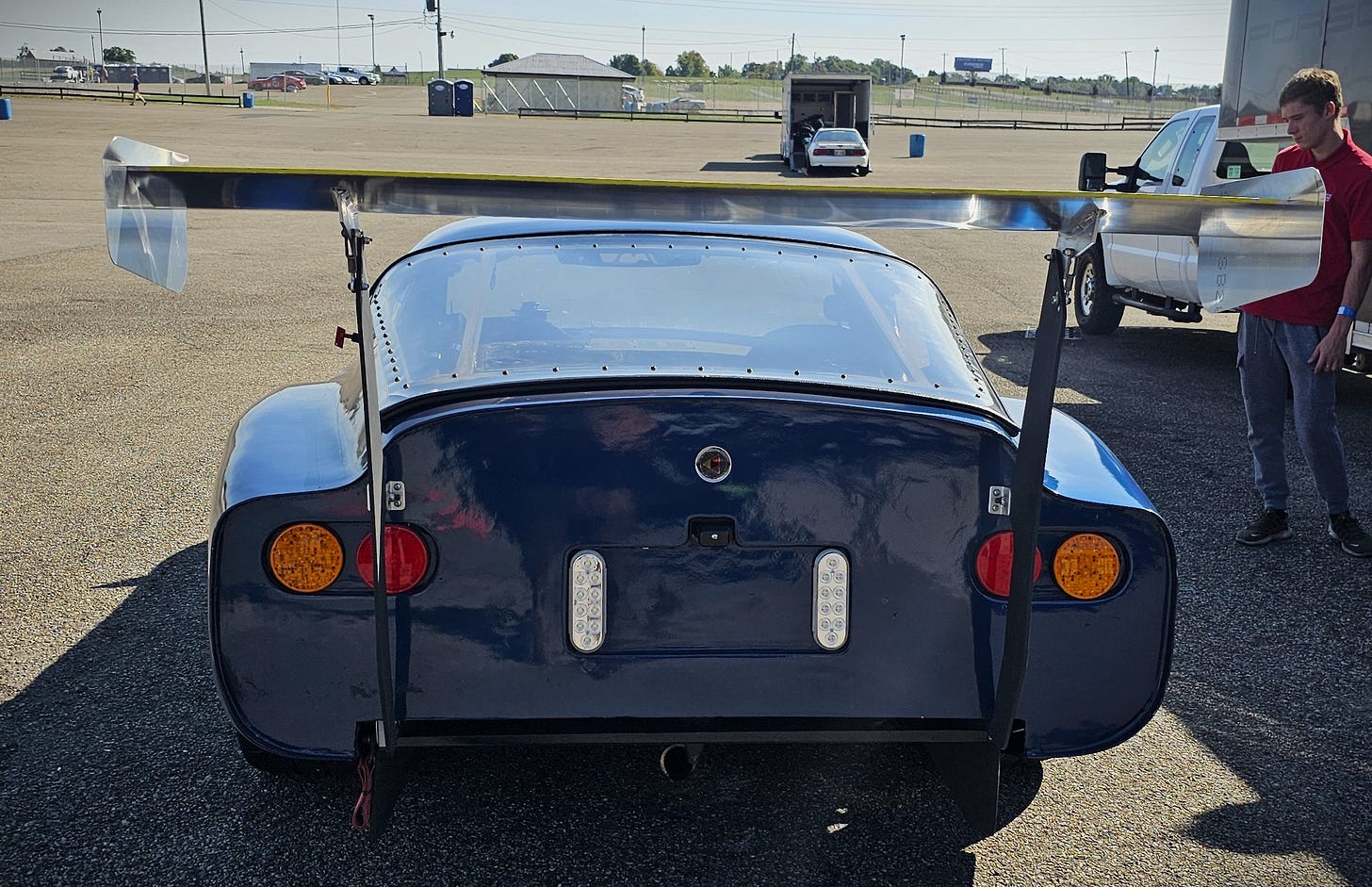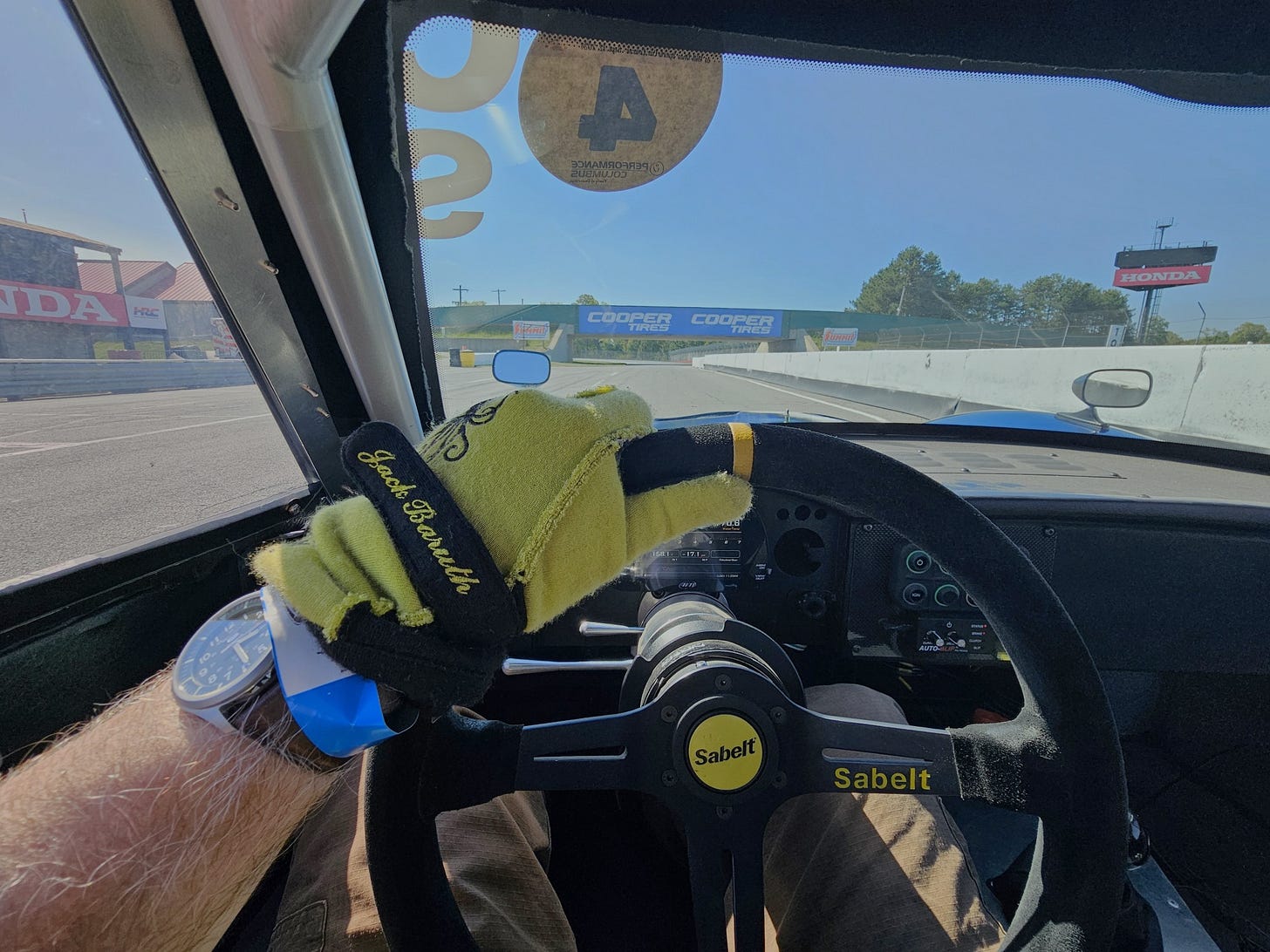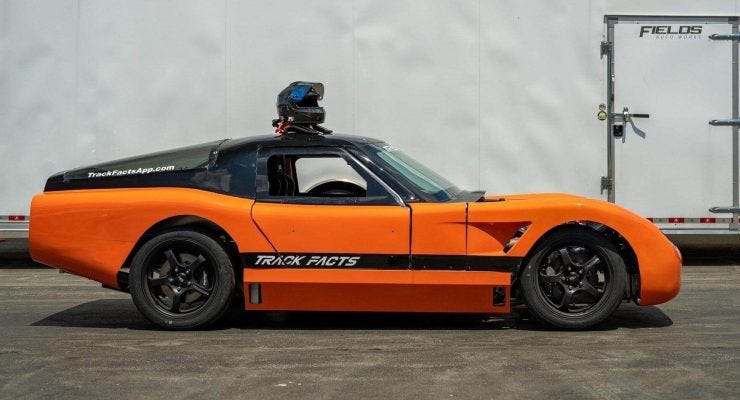Quick Track Test: Fields Cardinal Ecoboost
Open to all readers; all subscribers may comment
Our WCM Ultralite test at Waterford Hills was popular enough with readers for me to continue the series. Here’s another rare bird for your enjoyment: the Fields Cardinal, tested at Mid-Ohio this afternoon. For those of you who don’t know — and that’s probably most of you — Fields Auto Works is the automotive equivalent of a micro-brewery, located about an hour from me in Plain City, Ohio. They have a mid-engined carbon-fiber supercar, the Scioto, that has been sold with a variety of V-8 engines behind the driver. They also have a small roadster in the development phases. In between: the front-mid-engine Cardinal, Ohio made and nationally played.

Designed around the 300-horsepower 2.3-liter Ecoboost engine in longitudinal-mount trim as it appears in the current Mustang, the Cardinal troubles the scales by about half an S650’s weight. It’s not a kit car, which I think is important to know up front. Nor is it a Factory Five, hell-bent on using as many production components as possible. The best way to think of it is as a car built the old way: fiberglass body over steel space frame. Small-batch sports cars have ever been thus, even when the company building them was a major concern; there’s a reason the original Corvette wasn’t a steel body, and that reason was “saves money and complexity in the production process”.
The Internet thinks it looks like a Veyron thanks to the grille. In person, it shares just one quality with the famed Bugatti, namely: it’s a lot smaller than you’d expect. Just 156 inches on a 92 inch wheelbase, which places it neatly between the NC and ND Miatas. A look at the profile, however, will show you that the proportions aren’t the same.
The entire door is ahead of the seatbacks, which means that you, the driver, are more or less sitting on the rear axle. Most sports cars were like this back in the day — think E-Type, Lotus Seven, AC Ace/Cobra, and so on — but the most recent vehicles to use a similar packaging strategy were probably the GenV Viper and Mercedes-AMG SLS siblings. It takes some getting used to, and there’s a dynamic aspect to keep in mind that we’ll discuss later, but here’s the payoff for having an acre of bonnet visible ahead of you in a car the size of a 1988 Civic hatch back: the engine doesn’t hang over the front axle. Not much, anyway. More than it does in a Viper, less than in a G35.
Front-mid-engine layouts aren’t equal to true mid-engine layouts in terms of handling potential, largely because very few track drivers outside the autojourno grift weigh as much as a 2.3 Duratec with all its packaging. (370 pounds listed, before you ask. which is enough to teeter-totter even a Radwood “founder” or MAMA president off the ground.) They are, however, an entire laws-of-physics universe away from something like a modern Audi or Honda. Dedicating the front eighteen inches of a 156-inch-long car to empty air, therefore, can be taken as a fairly serious statement of intent.
It also makes the remarkable amount of room in the Cardinal’s cockpit all that more surprising. Your humble test driver, currently six foot two and lugging a positively Orson-Welles-esque 246 pounds, had all sorts of space available. Some of that is due to the thin fixed-back carbon buckets fitted to both Cardinals on hand at Mid-Ohio, but I’m pretty sure I could put a set of ND Miata Recaros in there and still be comfortable. Even better, I had an inch or two of free space between my helmet and the roof, something that doesn’t happen in much larger track-focused cars such as, for example, the GT3-class McLaren factory racers.
Let’s go for a drive.

Rob Fields, owner of Fields Auto Works, builds these cars one at a time. Almost anything is possible. Want comfy seats, Dynamat in the doors, a stereo system? Not a problem — and that’s how I’d have mine, with as much tweed and leather and wattage as I could pack in. This particular Cardinal, however, was conceived as a drive-to-the-track special. So there’s a robust cage, simple doors, and a minimalist approach. An eight-button soft-touch panel in the middle of the dash runs the car and the important functions. The variable power steering — yes, that’s a thing! — is controlled to the left of the steering wheel, with the variable rev-match — also a thing! — controlled to the right of the wheel. I didn’t fuss with either.
Out of an abundance of caution, Fields set the AIM dash to display speed, water temp, and oil temp for me rather than, say, predictive lap times. So I have no idea how quickly I went. I can tell you that the Cardinal has no trouble swanning past 130mph on the back straight before a conservatively early shove to the unboosted brakes. I’ve heard about lap times in the 1:32-1:34 range on MidOhio’s Club layout, given the right tires and a little bit of practice. I have no reason to disbelieve that.
For this session, I had some beater Falkens that howled on a fairly constant basis. In my first few laps I was cursing the Cardinal for being a slick-footed wobbly pig in every turn — and that’s when I took a minute to realize that I was setting my expectation for corner entry speeds via my (not always) trusty Radical SR8. Had I come to the Cardinal from a production street car, I’d likely have been amazed. Certainly it gets around Mid-Ohio faster than the last Lotus Evora 400 I drove there.
Once I got my head out of my RPE-V8, so to speak, it was easy to be both impressed and charmed by the Cardinal’s on-track aplomb. Rob has this customer-demo vehicle biased strongly to understeer, but that’s all variable because the car comes with double-A-arm suspension and pull-rod damper activation all the way around. In that respect, it’s a purer race car than 90% of the entries in a typical NASA “Thunder/Lightning” class.
The other Cardinal being driven on track today was in the custody of a late-teenaged instructor for the “AutoInterests” group. He came back and complained that “it understeers and oversteers at the same time”. Oh, you sweet summer child! That’s not what’s going on! It’s just that you’ve never sat far back enough in the car to actually feel it rotate around the (virtual, in this case, because it’s actually a fully independent pair of sticks) back axle!
This is also why so many Cobras and Vipers get crashed, by the way; until you’ve comfortable with the sensations of being so far away from the nose, the car will always feel out of control and give you feedback that you can’t use. Cardinal owners will surely attain that comfort over the course of a track day or two, at which point they can set their car up the way I’d adjust my Fields, which is to say: hang the ass out like a World of Outlaws car in steady-state cornering, and make sure it’s sitting on a Hoosier R7, at least. In that trim, with a little crank to the EcoBoost, it really is a solid contender for “drive to track and win NASA SU on the days when nothing prototype-shaped shows up”.
Surely this is the fastest sub-400hp street-usable track car you can easily buy. Which is reason enough to take it seriously. Think of it like a Westfield or Caterham where you’re not subject to molestation by the elements and also without the brick-wall aero problems above 100mph. On the Tail of the Dragon you’d be faster than 999 out of a thousand serious contenders.
Speaking of Westfield or Caterham: this is the part in the average “track special” review where a lot of hand-waving gets done about:
how much does it cost
can you register it at the DMV
who’s gonna fix it
where are the spare parts
and so on. The Cardinal gives you a minimum of that drama. Cost is about $70,000 fully built with a stock Ecoboost, plus the wacky options of your choice. Alternately, that money will buy you a Mustang Dark Horse, which will feel like an F-450 on the move compared to a Fields Cardinal. The car I drove had a legal tag on it. Fields can fix the car in a pinch, if you like, but I’d have zero concern about having the UNOH automotive-mechanic students who run my race cars also maintain this. The engine and electronics are straight Mustang. The rest of the spinning bits are easy to get to and fix. Since it’s not a kit car, I suspect you could get a loan for it about as easily as you can get a loan for a used Porsche or Ferrari, which is to say: credit scores above 720, with income that is both verifiable and sufficient.
There’s a lot to like about the Cardinal. What’s not to like? At least the following:
Fit and finish isn’t going to equal a new major-brand production car, inside or out. Hell, it’s not gonna match my 1986 Jaguar Vanden Plas, or my 1995 Plymouth Neon. If you’re the sort of Redditor who can distinguish between the interior quality of a new C-Class and a new 4-Series, this will have you clutching your Fleshlight in despair.
A certain amount of competence is required to operate it. Let’s set the bar for that at “capable of not crashing a 1988 Corvette or 1993 Viper when driving it quickly.” The majority of modern “sporty” drivers will need to train up to the mark, which is no problem. Rob will help you get there.
You might not like the way it looks, although I can tell you that in person it’s really neat. The blunt nose that seems Ssangyong-esque in photos makes perfect LMP-ish sense when you’re standing in front of it.
And… that’s about it.
Who’s the buyer for it? Well, return with me to the golden days of 2000, when your humble author spent $41,000 in total on a Superformance S1 from Dean Rosen at Dynamic Motorsports in Cincinnati, Ohio. As I recall, I put $20k in cash down and financed the rest via an unsecured three-year personal loan. That car got me one regional autocross championship, about 30 frustrating trackdays where I got passed by Z06es on every straight, and $19,000 in depreciation over the course of two years.
$41,000 in 2000 is… $76,500 in 2024. So the 29-year-old Jack Baruth who bought a Lotus Seven clone in Y2K could be shopping the Cardinal now. My God, would I have been better off and happier with this. I think the majority of Caterham buyers in the United States really want a Fields Cardinal, actually.
Maybe the most interesting comparison is with another $70,000-plus, 300-horsepower coupe: the 2024 base 2.0-liter Porsche Cayman. Some people will get in that Cayman and be just blown away by the sportiness of it, the handling, the power, and so on. They should buy a Cayman. It will be great for them, the way some people are just thrilled to listen to Taylor Swift’s newest whatever.
Other people will get in the 718 coupe and say, “Am I really about to drop this kind of money on something with V-6 Charger pace on the street and Spec Miata pace on the track, if I’m lucky? And how not excited am I about buying the absolute cheapest and weakest Porsche in the catalog, just because it’s quiet inside and vaguely resembles a 911?” Those people should call Rob Fields. He has the equivalent of Coca-Cola with the cocaine, Robitussin with the codeine, Jarts with the metal tip. Not as safe as your over-the-counter choices — but once you’ve had that Wizard-of-Oz color experience, it’s gonna be hard going back to Kansas.




There is no way in hell I am waiting until the next kitten thread to link this:
https://www.tiktok.com/@aiwiry1/video/7401489496635755783
"I had some beater Falkens that howled on a fairly constant basis."
I didn't realize Falkens were a problem until I put 4400 lbs around a roundabout a bit too fast and wore an uneven 10,000 miles off them in our CX-9. The next set will be a different brand.
I suspect with two or three days training I could drive this neat little racecar reasonably fast. Like the tractor article, this was something I didn't think I'd finish, but I was there at the end. Does it make me a midwit for wishing there were a few more pictures, though?